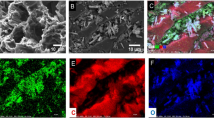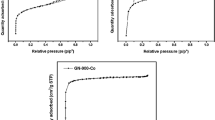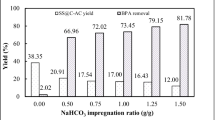Abstract
For a potential and efficient solution in the mitigation of aquatic pollution, this study reported a well-designed and developed protected granulated activated carbon (GAC) material which ensures high strength property and adsorption performance to meet the industrial application. The prepared GAC material was shaped into a spherical core using natural binders basically assumed to constitute waste solids materials. Then after, the granulated carbon core (GAC core) was protected by a porous ceramic shell which confined the material with strong protection and high mechanical strength to resist against degeneration and pressure drop as a limiting factor for most sorbents employed in solution. The CSGAC characterization results proved that the ceramic shell has a smaller thickness (0.1 cm), good mechanical strength (2.0 MPa), and additionally, it presents larger porous channels which promote the fast and higher adsorption performance making it the desired material for the application in the real liquid environment. The test results showed that the prepared material had higher removal of triclosan (TCS) (30–40 mg/L) than BPA counterpart from the aqueous solutions. Moreover, it showed higher adsorption performance compared to the unprotected carbon materials. Furthermore, the mechanisms of BPA and TCS adsorption by core-shell granulated activated carbon (CSGAC) were discussed.











Similar content being viewed by others
References
Alves ACF, Antero RVP, de Oliveira SB et al (2019) Activated carbon produced from waste coffee grounds for an effective removal of bisphenol-A in aqueous medium. Environ Sci Pollut Res 26:24850–24862. https://doi.org/10.1007/s11356-019-05717-7
Batra S, Datta D, Beesabathuni NS, Kanjolia N, Saha S (2019) Adsorption of Bisphenol-a from aqueous solution using Amberlite XAD-7 impregnated with Aliquat 336: batch, column, and design studies. Process Saf Environ Prot 122:232–246. https://doi.org/10.1016/j.psep.2018.12.005
Bautista-Toledo BI, Ferro-Garcia MA, Rivera-Utrilla J, Moreno-CastillaC FFJV (2005) Bisphenol A removal from water by activated carbon. Effects of carbon characteristics and solution chemistry. Environ Sci Technol 39:6246–6250. https://doi.org/10.1021/es0481169
Bayer P, Heur E, Karl U, Finkel M (2005) Economical and ecological comparison of granulated activated carbon (GAC) adsorbent refill strategies. Water Res 39:1719–1729. https://doi.org/10.1016/j.watres.2005.02.005
Behera SK, Oh SY, Park HS (2010) Sorption of triclosan onto activated carbon, kaolinite and montmorillonite: effects of pH, ionic strength, and humic acid. J Hazard 179:684–691. https://doi.org/10.1016/j.jhazmat.2010.03.056
Buth JM, Steen PO, Sueper C, Blumentritt D, Vikesland PJ, Arnold WA, McNeill K (2010) Dioxin photoproducts of triclosan and its chlorinated derivatives in sediment cores. Environ Sci Technol 44:4545–4551. https://doi.org/10.1021/es1001105
Calafat AM, Kuklenyik Z, Reidy JA, Caudill SP, Ekong J, Needham LL (2005) Urinary concentrations of bisphenol a and 4-nonylphenol in a human reference population. Environ Health Perspect 113:391–395. https://doi.org/10.1289/ehp.7534
Calafat AM, Ye XY, Wong LY, ReidyJA NLL (2008) Exposure of the US population to bisphenol a and 4-tertiary-octylphenol: 2003-2004. Environ Health Perspect 116:39–44. https://doi.org/10.1289/ehp.10753
Cho HH, Huang H, Schwab K (2011) Effects of solution chemistry on the adsorption of ibuprofen and Triclosan onto carbon nanotubes. Langmuir. 27:12960–12967. https://doi.org/10.1021/la202459g
Cui L, Wei J, Du X, Zhou X (2016) Preparation and evaluation of self- assembled porous microspheres—fiber for removal of bisphenol a from aqueous solution. Ind Eng Chem Res 55:1566–1574. https://doi.org/10.1021/acs.iecr.5b04306
Dann AB, Hontela A (2011) Triclosan: environmental exposure, toxicity and mechanisms of action. J Appl Toxicol 31:285–311. https://doi.org/10.1002/jat.1660
Fenichel P, Chevalier N, Brucker-Devis F (2013) Bisphenol a: an endocrine and metabolic disruptor. Ann Endocrinol 74:211–220. https://doi.org/10.1016/j.ando.2013.04.002
Fiss EM, Rule KL, Vikesland PJ (2007) Formation of chloroform and other chlorinated byproducts by chlorination of triclosan-containing antibacterial products. Environ Sci Technol 41:2387–2394. https://doi.org/10.1021/es062227l
Guo Y, Du E (2012) The effects of thermal regeneration conditions and inorganic compounds on the characteristics of activated carbon used in power plant. Energy Proc 17:444–449. https://doi.org/10.1016/j.egypro.2012.02.118
Jeswani HK, Gujba H, Brown NW, Roberts EPL, Azapagic A (2015) Removal of organic compounds from water: life cycle environmental impacts and economic costs of the Arvia process compared to granulated activated carbon. J Clean Prod 89:203–213. https://doi.org/10.1016/j.jclepro.2014.11.017
Joseph L, Zaib Q, Khan IA, Berge ND, Park YG, Saleh NB, Yoon Y (2011) Removal of bisphenol a and 17 alpha-ethinyl estradiol from landfill leachate using single-walled carbon nanotubes. Water Res 45:4056–4068. https://doi.org/10.1016/j.watres.2011.05.015
Jun B-M, Hwang HS, Heo J, Han J, Jang M, Sohn J, Park CM, Yoon Y (2019) Removal of selected endocrine-disrupting compounds using Al-based metal organic framework: performance and mechanism of competitive adsorption. J Ind Eng Chem 79:345–352. https://doi.org/10.1016/j.jiec.2019.07.009
Jung C, Son A, Her N, Zoh KD, Cho J, Yoon Y (2015) Removal of endocrine disrupting compounds, pharmaceuticals, and personal care products in water using carbon nanotubes: a review. J Ind Eng Chem 27:1–11. https://doi.org/10.1016/j.jiec.2014.12.035
Kabir ER, Rahman S, Rahman I (2015) A review on endocrine disruptors and their possible impacts on human health. Environ Toxicol Pharmacol 40:241–258. https://doi.org/10.1016/j.etap.2015.06.009
Katsigiannis A, Noutsopoulos C, Mantziaras J, Gioldasi M (2015) Removal of emerging pollutants through granular activated carbon. Chem Eng J 280:49–57. https://doi.org/10.1016/j.cej.2015.05.109
Kaur H, Bansiwal A, Hippargi G et al (2018) Effect of hydrophobicity of pharmaceuticals and personal care products for adsorption on activated carbon: adsorption isotherms, kinetics and mechanism. Environ Sci Pollut Res 25:20473–20485. https://doi.org/10.1007/s11356-017-0054-7
Khraisheh M, Kim J, Campos L, Al-Muhtaseb AH, Al-Hawari A, Al Ghouti M et al (2014) Removal of pharmaceutical and personal care products (PPCPs) pollutants from water by novel TiO2–coconut Shell powder (TCNSP) composite. J Ind EngChem 20:979–987. https://doi.org/10.1016/j.jiec.2013.06.032
Koduru JR, Lingamdinne LP, Singh J, Choo KH (2016) Effective removal of bisphenol-a (BPA) from water using a goethite/activated carbon composite. Process Saf Environ Prot 103:87–96. https://doi.org/10.1016/j.psep.2016.06.038
Kong L, Su M, La PengY H, Liu J, Li H, Diao Z, Shih K, Xiong Y, Chen D (2017) Producing sawdust derived activated carbon by co-calcinations with limestone for enhanced acid Orange II adsorption. J Clean Prod 168:22–29. https://doi.org/10.1016/j.jclepro.2017.09.005
Lambert SD, Miguel GS, Graham NJD (2002) Deleterious effects of inorganic compounds during thermal regeneration of GAC: a review. J Am Water Works Assoc 94:109–119. https://doi.org/10.1002/j.1551-8833.2002.tb10253.x
Lei C, Hu Y-y, He M-z (2013) Adsorption characteristics of triclosan from aqueous solution onto cetylpyridinium bromide (CPB) modified zeolites. Chem Eng J 219:361–370. https://doi.org/10.1016/j.cej.2012.12.099
Li S, Gong Y, Ynag Y, He C, Hu L, Zhu L, Shu D (2015) Recyclable CNTs/Fe3O4 magnetic nanocomposites as adsorbents to remove bisphenol a from water and their regeneration. Chem Eng J 260:231–239. https://doi.org/10.1016/j.cej.2014.09.032
Ndagijimana P, Xuejiao L, Guangwei Y, Yin W (2019a) Synthesis of a novel core-shell-structure activated carbon material and its application in sulfamethoxazole adsorption. J Hazard Mater 368:602–612. https://doi.org/10.1016/j.jhazmat.2019.01.093
Ndagijimana P, Xuejiao L, Zhiwei L, GuanweiY YW (2019b) Optimized synthesis of a core-shell structure activated carbon and its adsorption performance for Bisphenol a. Sci Total Environ 689:457–468. https://doi.org/10.1016/j.scitotenv.2019.06.235
Sudhakar P, Mall ID, Srivastava VC (2016) Adsorptive removal of bisphenol a by rice husk ash and granular activated carbon – a comparative study. Desalination Water Treat 57:12375–12384. https://doi.org/10.1080/19443994.2015.1050700
Sun W, Wang C, Pan W, Li S, Chen B (2017) Effects of natural minerals on the adsorption of 17β-estradiol and bisphenol a on graphene oxide and reduced graphene oxide. Environ. Sci Nano 4:1377–1388. https://doi.org/10.1039/C7EN00295E
Tan IAW, Ahmad AL, Hameed BH (2008) Adsorption of basic dye on high-surface-area activated carbon prepared from coconut husk: equilibrium, kinetic and thermodynamic studies. J Hazard Mater 154:337–346. https://doi.org/10.1016/j.jhazmat.2007.10.031
Thanhmingliana SM, Tiwari Lee D (2014) Use of hybrid materials in the decontamination of bisphenol a from aqueous solution. RSC Adv 4:43921–43930. https://doi.org/10.1039/C4RA06793B
Thompson A, Griffin P, Stuetz R, Cartmell E (2005) The fate and removal of triclosan during wastewater treatment. Water Environ Res 77:63–67. https://doi.org/10.2175/106143005x41636
Wang F, Lu X, Peng W, Deng Y, Zhang T, Hu Y-B, Li XY (2017) Sorption behavior of bisphenol A and triclosan by graphene: comparison with activated carbon. ACS Omega 2:5378–5384. https://doi.org/10.1021/acsomega.7b00616
Wu WJ, Hu YY, Guo Q, Yan J, Chen YC, Cheng JH (2015) Sorption/desorption behavior of triclosan in sediment-water-rhamnolipid systems: effects of pH, ionic strength, and DOM. J Hazard Mater 297:59–65. https://doi.org/10.1016/j.jhazmat.2015.04.078
Wu P, Cai Z, Jin H, Tang Y (2019) Adsorption mechanisms of five bisphenol analogues on PVC microplastics. Sci Total Environ 650:671–678. https://doi.org/10.1016/j.scitotenv.2018.09.049
Xie HJ, Yang YX, Liu JH, Kang Y, Zhang J, Hu Z, Liang S (2018) Enhanced triclosan and nutrient removal performance in vertical up-flow constructed wetlands with manganese oxides. Water Res 143:457–466. https://doi.org/10.1016/j.watres.2018.05.061
Acknowledgments
This research was supported by the Strategic Priority Research Program of the Chinese Academy of Sciences [Grant 467 No.XDA23030301, XDA23020500], China-Japan Research Cooperative Program [Grant No. 2016YFE0118000], the Natural Science Foundation of Fujian Province (2019J01135), the Science and technology program of Xiamen [3502Z20193076]; and support provided by CAS-TWAS President’s Fellowship Program.
Author information
Authors and Affiliations
Corresponding authors
Additional information
Responsible editor: Tito Roberto Cadaval Jr
Publisher’s note
Springer Nature remains neutral with regard to jurisdictional claims in published maps and institutional affiliations.
Electronic supplementary material
ESM 1
(DOCX 24 kb)
Rights and permissions
About this article
Cite this article
Ndagijimana, P., Liu, X., Li, Z. et al. The synthesis strategy to enhance the performance and cyclic utilization of granulated activated carbon-based sorbent for bisphenol A and triclosan removal. Environ Sci Pollut Res 27, 15758–15771 (2020). https://doi.org/10.1007/s11356-020-08095-7
Received:
Accepted:
Published:
Issue Date:
DOI: https://doi.org/10.1007/s11356-020-08095-7




